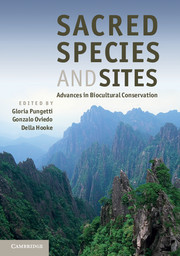Book contents
- Frontmatter
- Contents
- List of Contributors
- Foreword
- Preface
- Acknowledgements
- Introduction
- Part I Concepts and Knowledge
- Part II Sacred Landscapes
- Part III Sacred Sites and People
- Part IV Sacred Species
- Part V Sacred Animals
- 17 Genealogy of the sacred: Maori beliefs concerning lizards
- 18 Pheasant conservation, sacred groves and local culture in Sichuan, China
- 19 The bear cult among the different ethnic groups of Russia (sacred Russian bear)
- 20 Specific-species taboos and biodiversity conservation in Northern Madagascar
- Part VI Sacred Groves and Plants
- Part VII Implementation and Conclusions
- Index
- Plate Section
- References
18 - Pheasant conservation, sacred groves and local culture in Sichuan, China
from Part V - Sacred Animals
Published online by Cambridge University Press: 05 August 2012
- Frontmatter
- Contents
- List of Contributors
- Foreword
- Preface
- Acknowledgements
- Introduction
- Part I Concepts and Knowledge
- Part II Sacred Landscapes
- Part III Sacred Sites and People
- Part IV Sacred Species
- Part V Sacred Animals
- 17 Genealogy of the sacred: Maori beliefs concerning lizards
- 18 Pheasant conservation, sacred groves and local culture in Sichuan, China
- 19 The bear cult among the different ethnic groups of Russia (sacred Russian bear)
- 20 Specific-species taboos and biodiversity conservation in Northern Madagascar
- Part VI Sacred Groves and Plants
- Part VII Implementation and Conclusions
- Index
- Plate Section
- References
Summary
Introduction
Natural resources and people are intrinsically linked: religious, moral, cultural, political, economic and ecological boundaries have all shaped environmental use and perceptions (Gosling, 2001). Historically, attitudes and behaviour towards the environment and sustainable use of resources have been greatly affected and determined by nature worship and spiritual values (Khumbongmayum et al., 2004; Byers et al., 2001). To develop moral standards towards the community and local habitats, many cultures have formed values and beliefs to control acceptable behaviour (Goldstein and Kapstein, 1998; Laird, 1993). Conceptual traditions have, as a result, placed high values on protecting the environment and biodiversity. In this chapter we describe the relationship between cultural values (including spiritual beliefs) and nature in western Sichuan, China. Specifically, we introduce Doacheng County and its people, indicate the importance of China to global wildlife conservation and especially for pheasants, and explore the potential for traditional beliefs to play a meaningful role in conserving certain species and habitats.
Sichuan
The link between cultural and biological diversity is clearly demonstrated in south-west China with cultural and historic ties to mountain landscapes and ecosystems. With more than 30 different ethnic minority groups many landscapes are regarded as sacred, in particular those of the Tibetan people (Xu et al., 2006). Tibetan society is dominated by Buddhism, which plays a central role, and its core notions of karma, reincarnation and enlightenment define the basic meaning of life and morality (Goldstein and Kapstein, 1998). Buddhism also influences daily Tibetan life, which is considered to be a non-material cycle of cause and effect, with reincarnation determined by human behaviour (Xu, 2006).
- Type
- Chapter
- Information
- Sacred Species and SitesAdvances in Biocultural Conservation, pp. 265 - 277Publisher: Cambridge University PressPrint publication year: 2012



